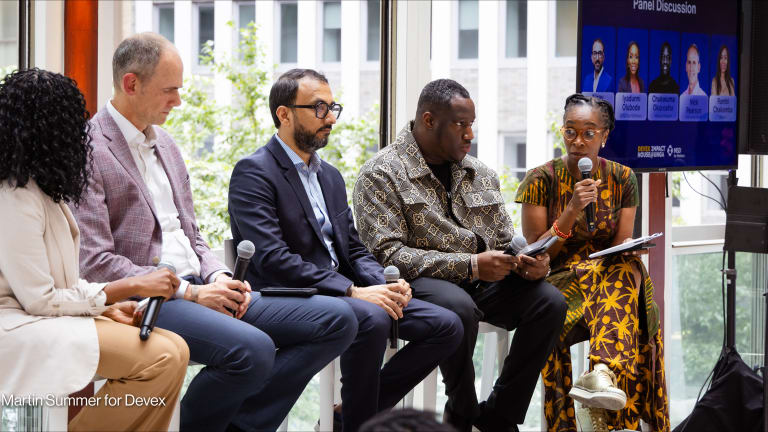
“The private sector has a lot to contribute and what it needs is responsible funding from both donors and governments to ensure that the initiatives are sustainable,” according to Audrey Obara, head of health at Swedfund, Sweden’s development finance institution.
That’s especially true, Obara said, when it comes to reproductive, maternal, newborn, child, and adolescent health. The private sector can provide services and goods while often being a source of innovative solutions.
For example, Jacaranda Health, which both Swedfund and MSD for Mothers supports, opened Nairobi’s first mobile maternal health to improve access to such services. With continued support, the initiative has scaled, running two maternal health delivery centers in periurban areas that offer affordable patient-centered care.
But if such solutions are to be scaled up and implemented to tackle the challenges in the sector such as the over 800 women that die daily from complications due to childbirth and pregnancy — more funding behind them is needed.
Donor funding is sometimes needed to prove a certain concept or to scale up a particular idea, Obara said. “Private capital then comes in quite handy at that point [of scale] because donor funding may not be there sustainably for a very long time. It may go into other projects.”
Speaking to Devex, she explained how Swedfund works with the private sector, the lessons it’s learned in doing so, and how it keeps a track of its engagement.
This conversation has been edited for length and clarity.
Why do you think it’s important to partner with the private sector, particularly in the area of RMNCAH?
The private sector provides goods and services in the area of RMNCAH complementing other stakeholders and, in some cases, working alongside other stakeholders. Private sector players aim to be competitive, driving down prices and innovating in the production of goods, delivery of services, and creating better supply chains. The effect of all these initiatives is continuous improvement in quality and reduction of prices due to efficiency and scale.
What is the best way of integrating local private sector actors into the health ecosystem and for donors to support them?
Regulators need to establish adequate rules and regulations on what private sector actors can do, which services they can provide, and the minimum quality standards they must adhere to. Once the regulatory environment is well-established, transparent, and stable, private sector actors can set up enterprises to provide goods and services that meet regulatory requirements, commit capital to establish, or grow their enterprises against a stable regulatory regime and complement the health ecosystem in a responsible manner.
“A key lesson is to work with strong partners while making investments in the private sector to ensure alignment in the goals that we want to achieve and the impact we want to create.”
— Audrey Obara, head of health, SwedfundHow does Swedfund engage with the private sector?
Swedfund invests in the private sector in developing countries, specifically to strengthen the resilience of communities and individuals and to contribute toward the sustainable development of private sector companies. We work with companies that are aligned with our mission to contribute to the reduction of poverty. We want to create decent working conditions, empower women in these economies, reduce climate impacts, and, quite importantly, we want to mobilize additional private capital because we don’t see a lot of private capital in these markets. Then we want to engage with various private sector bodies, associations, and initiatives to build our knowledge and experience to then contribute to strengthening the health systems.
There is also direct and indirect engagement with the public sector through Swedfund’s private sector support. For instance, with the pandemic, there is a lot of collaboration on vaccines … with the private sector supporting the public sector to distribute vaccines to reach a wider number in the community. Swedfund supports companies that produce critical goods such as medicines and consumables that are used by both [the] public and private sector.
Are there any lessons Swedfund has learned in working with the private sector?
A key lesson is to work with strong partners while making investments in the private sector to ensure alignment in the goals that we want to achieve and the impact we want to create.
Whenever we look at any investment, we look at three cornerstones or pillars. Number one, the impact to society that this investment would generate in terms of how many patients are treated, how many jobs they create, how many skills — specialized — they’re enhancing, and what they’re contributing within the wider community such as taxes, etc.
Private sector engagement
As defined by the Organisation for Economic Co-operation and Development, this is an activity that aims to engage the private sector for development results, which involve the active participation of the private sector.
The definition is deliberately broad in order to capture all modalities for engaging the private sector in development cooperation, from informal collaborations to more formalized partnerships.
Read more about the definition and how Maternity Matters: Funding the Future is exploring the topic.
Next, we look at sustainability: Do they have environmental policies? Are they following them? Are the sustainability gaps that were identified before the investment closed within agreed timelines? Are they safe in terms of the quality of services that the entity provides? Are they following all the local laws and regulations?
Then the third pillar is financial viability. Is the company able to cover its costs and operate in a financially sustainable manner and not have to shut down after a while because it’s not able to cover all its operational costs?
We support our companies to improve when it comes to environmental matters, we support them to improve on social matters, [and] we look at areas such as worker safety. We also want our companies to contribute within the societies they’re in through decent jobs, paying taxes, and being responsible.
We do not only assess the financing or investment return but consider other contributions that the entities can make at the individual, community, and population level. We want to improve the skills and the knowledge — especially where there are specialist skills gaps — of the employees in the companies that we invest in.
How are you tracking Swedfund’s engagement with the private sector in the area of RMNCAH?
At the point of making an investment, we set qualitative and quantitative targets that we would like the company to achieve, and [define] the support required. Annually, we measure how the company is developing against these targets and if there are deviations, how we can support the company to get back on track. For some investments, we will take a board seat to support the strategic development of the company. We also use technical assistance funding to bolster certain areas of operations where we see the company could benefit from improving those areas of operation — sustainability being one of them, gender and skills being another one, climate, human rights, and digitalization as well.
My reflection would be that it’s important to have a baseline when you look at an investment and you commence that process. What are the targets you want to achieve? Track that as you go along, and this is across all of the three pillars. If you do not have that baseline, sometimes you will not understand where the company is falling short and then you won’t be able to come up with appropriate interventions. For instance, if a company said they were going to reach this number of people and then you find they are falling short of that, when you track that it is very clear, and you can then have a discussion with the company on the interventions and support required.
The Funding the Future series is supported by funding from MSD, through its MSD for Mothers program and is the sole responsibility of the authors. MSD for Mothers is an initiative of Merck & Co., Inc., Kenilworth, NJ, U.S.A.









